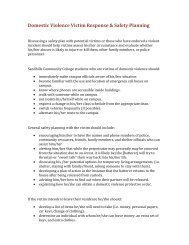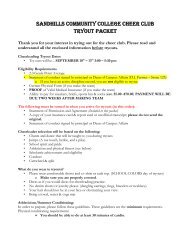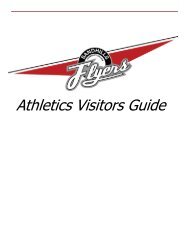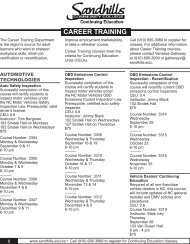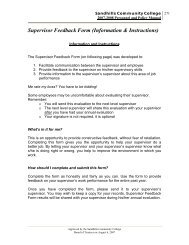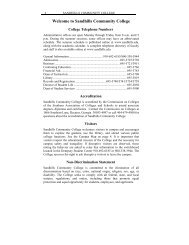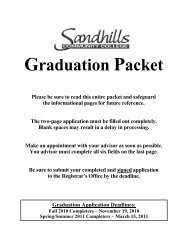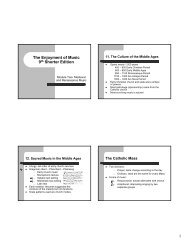Web Style Guide: TYPOGRAPHY - Sandhills Community College
Web Style Guide: TYPOGRAPHY - Sandhills Community College
Web Style Guide: TYPOGRAPHY - Sandhills Community College
You also want an ePaper? Increase the reach of your titles
YUMPU automatically turns print PDFs into web optimized ePapers that Google loves.
<strong>Web</strong> <strong>Style</strong> <strong>Guide</strong>: <strong>TYPOGRAPHY</strong><br />
Times New Roman is a good example of a traditional typeface that has been adapted for use on<br />
computer screens. A serif typeface like Times New Roman (the default text face in most <strong>Web</strong> browsers)<br />
is about average in legibility on the computer screen, with a moderate x-height. Times New Roman is a<br />
good font to use in text-heavy documents that will probably be printed by readers rather than read from<br />
the screen. The compact letter size of Times New Roman also makes it a good choice if you need to<br />
pack a lot of words into a small space.<br />
Designed for the screen<br />
Typefaces such as Georgia and Verdana were designed specifically for legibility on the computer<br />
screen; they have exaggerated x-heights and are very large compared to more traditional typefaces in the<br />
same point size. These fonts offer excellent legibility for <strong>Web</strong> pages designed to be read directly from<br />
the screen. However, the exaggerated x-heights and heavy letterforms of these fonts look massive and<br />
clumsy when transferred to the high-resolution medium of paper.<br />
Choosing typefaces<br />
The most conventional scheme for using typefaces is to use a serif face such as Times New Roman or<br />
Georgia for body text and a sans serif face such as Verdana or Arial as a contrast for headlines. We<br />
generally set our text-laden <strong>Web</strong> pages in Times New Roman because it produces a reasonable balance<br />
between density of information and overall legibility. Most readers expect a serif font for long blocks of<br />
text and find Times New Roman comfortable to read off-screen from paper printouts. Various studies<br />
purport to show that serif type is more legible than sans serif type and vice versa. You can truly judge<br />
type legibility only within the context of the situation — on the screen — as users will see your <strong>Web</strong><br />
page.<br />
You may use either a variation of the serif font or a contrasting sans serif face for the display type. It is<br />
safest to use a single typographic family and vary its weight and size for display type and emphasis. If<br />
you choose to combine serif and sans serif faces, select fonts that are compatible and don't use more than<br />
two typefaces (one serif, one sans serif) on a page.<br />
The most useful fonts that ship with the Apple Macintosh and Microsoft Windows operating systems are<br />
reproduced here (we have omitted bitmap fonts and decorative or novelty typefaces):<br />
http://webstyleguide.com/type/print/type.html (15 of 31)5/17/2005 5:18:39 PM



